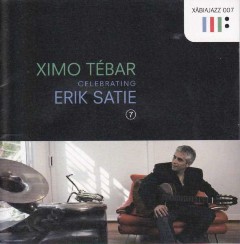Ximo Tebar - Celebrating Erik Satie (2009)
Ximo Tebar - Celebrating Erik Satie (2009)

1 Gnossienne 3 11:59 2 Idylle 5:26 3 Gymnopédie 1 5:48 4 Embryons Desséchés 2 5:38 5 Croquis Et Agaceries D'un Gros Bonhomme En Bois 4:54 6 En Habit De Cheval 3-4 5:20 7 Airs À Faire Fuir 2 6:03 8 Véritables Préludes Flasques (Pour Un Chien) 2: Seul À La Maison 4:40 9 Gnossienne 1 8:30 10 A Solas Con Satie 2:21 Bass – Boris Kozlov Drums – Donald Edwards Electric Piano [Rhodes] – Orrin Evans Electric Piano [Rhodes], Synthesizer – Jim Ridl Guitar – Ximo Tébar Soprano Saxophone – Ramón Cardo (tracks: 3), Stacy Dillard Trombone – Carlos Martin (tracks: 3), Robin Eubanks Trumpet – David Pastor (tracks: 3), Sean Jones
Celebrating Erik Satie represents a creative and stimulating selection of jazz arrangements and improvisations. Ximo Tebar is a respected guitarist and creative force from Spain who has taken the compositions of the eccentric, irascible, and innovative French composer and transmuted them into jazz ensemble performances. Tebar shakes things up while retaining enough straight-ahead jazz to appeal to the masses; it's no accident that "En Habit de Cheval" possesses a clear reference to John Coltrane's magnum opus, A Love Supreme (Impulse!, 1964). Like Coltrane, Tebar is fortunate enough to have recruited other outstanding musicians who can implement his complex ideas.
The watchword of this album is "plays," with the implications of irony and humor, tinged with Chaplin-esque sadness that characterizes what Tebar and his ensemble, taking a cue from Satie, offer. Satie was an inventive, experimenting composer who influenced musical impressionism and minimalism, which in turn strongly impacted modern jazz. For a period of time, he played in cabarets in the Parisian district of Monmartre and wrote popular songs.
Tebar, however, is careful not to imitate Satie. Rather, he takes rhythms, extracts, ideas, and motifs from Satie's compositions, gives them ironic twists, and transforms them into his own and the group's thoughts and sounds. On "Gnossiene 3," for example, Tebar begins with an outer space, sci-fi movie intro, and then drifts off with his group into a relaxed, easy-going, straight-ahead set of improvisations. Then he adds a unique plunger mute "talking" effect on the guitar, which he makes use of periodically throughout the album.
"Idylle" goes on a slow walk, with Satie's sense of irony and play, and a gnome-like flavor leading up to very nice co-improvised contrapuntal section. "Gymnopedie 1" is the famous melody that Woody Allen used in his 1986 film Hannah and Her Sisters. The group gives the song, intended as a dance piece, a nice lilt, presaging "Embryons Desseaches," with Tebar's soft guitar work against a background of a halting dance rhythm. "Croquis et Agaceries D'un Gros Bonhomme en Bois" includes some beautiful work by trombonist Robin Eubanks and trumpeter Sean Jones. "En Habit de Chaeval" incorporates Bach-like counterpoint and brass ensemble effects, leading up to rapid double-time improvs by trumpet, sax, and trombone, while "Airs a Faire Fuir 2" is a quiet, contemplative piece with a gentle melodic theme.
Tebar transmutes "Gnossienne 1" into a conversation among lost souls, with a superb trombone cadenza by Eubanks, followed by group breaking out into an upbeat rendition of Satie's theme, including some fine straight-ahead playing by Tebar. The only melody not composed by Satie, "A Solas con Satie."(translation: "Alone with Satie") closes the set; a lovely testament to Tebar's affection for—and his sense of soul brotherhood with Satie—it brings together the Spanish and French influences of this fine recording. ---Victor L. Schermer, allaboutjazz.com
El músico valenciano Ximo Tébar, con una larga trayectoria en el jazz, se ha aproximado a la música clásica con su último disco "Celebrating Erik Satie". El trabajo es fruto de un encargo del festival Xàbia Jazz, que organizan el Institut Valencià de la Música y el Ayuntamiento de esa ciudad alicantina, estrenado en 2008 y recogido ahora en un disco, el séptimo de la colección.
Ximo Tébar ha recalcado lo ambicioso del disco, que ha requerido multitud de medios, y ha agradecido al IVM su implicación en él. La grabación comprende nueve composiciones de Satie, en su mayoría con arreglos de Tébar, además de una pieza creada por el guitarrista valenciano, en un estilo que se mueve entre el funky y el chill out.
Tébar ha contado para este disco con la participación de algunos de los más relevantes músicos de jazz actuales: Sean Jones (trompeta), Robin Eubanks (trombón), Stacy Dillard (saxo soprano), Jim Ridl (teclado y sintetizador), Orrin Evans (teclado), Boris Kozlov (bajo) y Donald Edwards (batería), aunque para una de las piezas reunió a algunos destacados jazzistas valencianos como Ramón Cardo (saxo soprano), David Pastor (trompeta) y Carlos Martín (trombón).
Considerado el precursor del minimalismo, Satie (1866-1925) fue un compositor y pianista con una vida y obra marcadas por la genialidad, la excentricidad y la irreverencia. Huyó del academicismo y trabajó en los cabarets parisinos. La sencillez y el lirismo caracterizan buena parte de su producción, que ejerció una notable influencia sobre Debussy y Ravel entre otros contemporáneos suyos. ---La trompa de Eustaquio, jazzitis.com
download (mp3 @320 kbs):
yandex mediafire uloz.to cloudmailru gett








